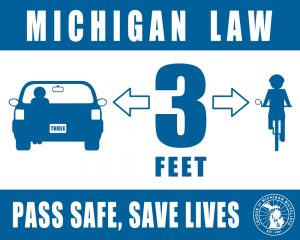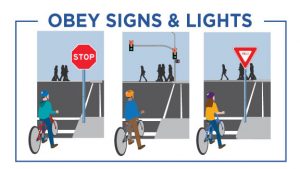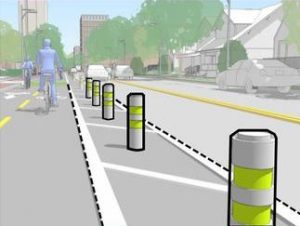Non-Motorized Safety—It's a Three-Way Street
By Dave Austin, PE
Over the past several years, Williams & Works has been involved in the planning, design and construction of numerous non-motorized transportation projects including long distance regional pathways, Safe Routes to School sidewalk systems, on-street and separated bike lanes, and hiking trails. The increase in this type of assignment stems, in large part, from the desire of communities to promote a healthier lifestyle and to provide a safe means for people to access community facilities, shopping, schools, and employment in something other than a motorized vehicle. But with increased non-motorized transportation comes a need for public education changing on traffic safety. The National Highway Traffic Safety Administration shows that while overall traffic deaths in the United States has declined 1% since 2016, deaths involving pedestrians and cyclists have increased by 4% and 10% respectively during that same time frame. The web is full of articles representing all sides of the issue, each with a stack of facts supporting that the other guys are responsible for this increase; and you know what? They are all correct.
I drive a car. Including commuting, driving to/from client meetings around the state and non-work trips, about 30,000 miles per year. I walk about 3-4 miles a day and this year was able to log about 2,500 miles on my bicycle. I’m also a civil engineer involved in designing street and non-motorized facilities for communities, so when this topic comes up, I look at it from all three of those angles. For what it’s worth, here is my take on how to decrease pedestrian / cyclist fatalities using a few of my own bad habits as an outline.
- Park your car, take a walk, ride a bike. – No, I’m not suggesting you get rid of your vehicle (but using it less is a good idea). What I’m suggesting is to literally walk/bike a few miles in my shoes. Until you experience the rush of a 3,000 lb. mass of metal fly by inches away from you, or traverse a busy urban streetscape on foot, dodging pre-occupied office workers, you can’t really appreciate how fragile these relationships are. You will drive differently, I promise.
- Share the Road – Michigan law requires drivers to provide a minimum of 3-feet of room while passing bicyclists on the road.
- Put down your phone – Deaths due to distracted driving are on a frightening uptick. According to some sources, texting and driving is equivalent to being 4 times over the legal alcohol limit. At only 25 miles per hour, your vehicle has traveled over the length of a football field in the time it took you to read this sentence. Whatever it is, it is not that important.
- Give yourself more time – When we rush, we speed, we are distracted, and more prone to driving errors and less tolerant of slowdowns, including pedestrians.Slowing down from 45 mph to the posted 35 mph for a 5-mile commute adds only 2 minutes to the journey.
- Look out for pedestrians and cyclists – Pay attention. They are out there. Whether you think it is right or wrong for them to be there, give them space. Killing or injuring someone isn’t worth the debate.
- Drive Straight – Sober driving only.
- Obey Traffic Laws – Pedestrians: cross at the corner, at the light, at the crosswalk, at places where motorists should expect to see you. Jaywalking and midblock crossings are dangerous. Cyclists: stop at stop signs and red lights, use hand signals when turning, do not pass cars on the right, on the shoulder. If you want to share the road, share the road laws.
- Be Seen – Fashion be damned. Lights, fluorescent clothing. Flashing lights. More lights.
- Look out for cars – Do not assume they are looking out for you. Particularly at intersections. While you may be lawfully right, you’ll be dead right.
- Put down your phone – While not traveling fast, pedestrians walking into traffic or cyclists checking their riding stats can cause unsafe distractions.
- Use trails – When available, use them. Yes, they may be slower.
- Make non-motorized facilities a requirement, not an amenity – Like it or not, pedestrians and cyclist are here to stay. We need to continue to take into account these modes of transportation for all of our planning, design and funding activities - and not just as an afterthought. It may cost more and take more space and slow down the motorized vehicles. What’s the rush?
The responsibility for lowering the rate of pedestrian and cycling deaths is shared with the motorists, the pedestrian/cyclist and those of us involved with the planning, design and funding of our transportation infrastructure. By being smarter and more aware of each other, we can safely share the road.



